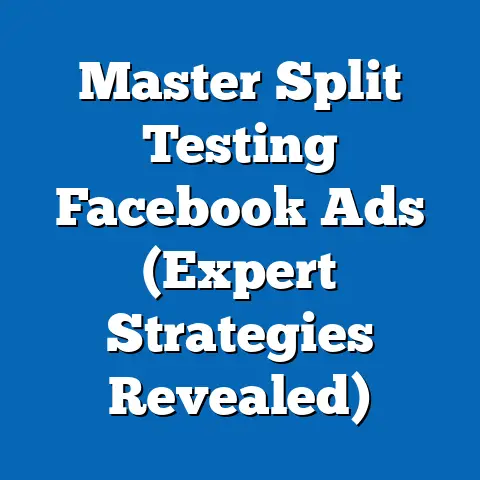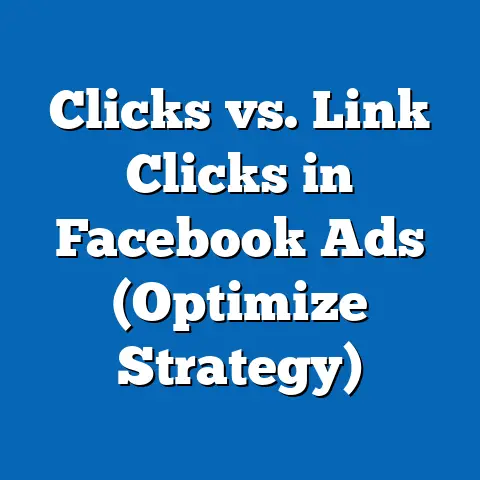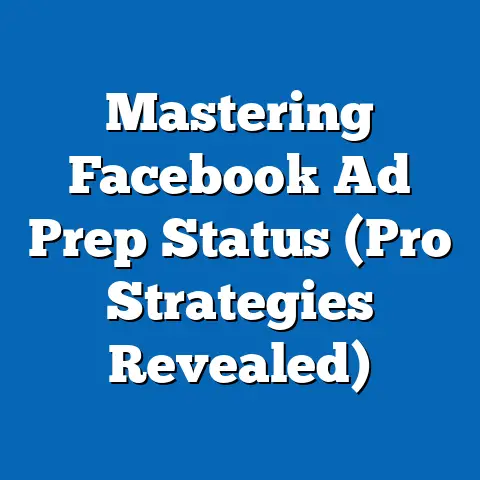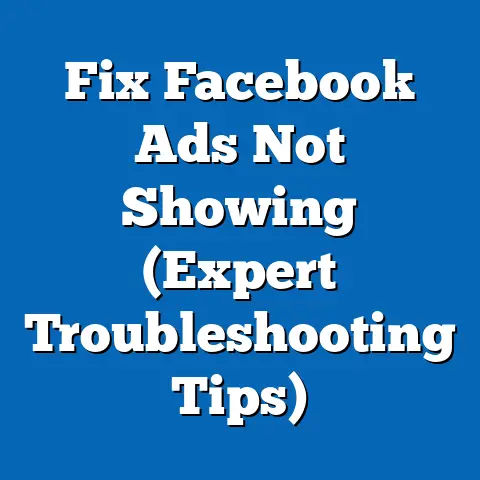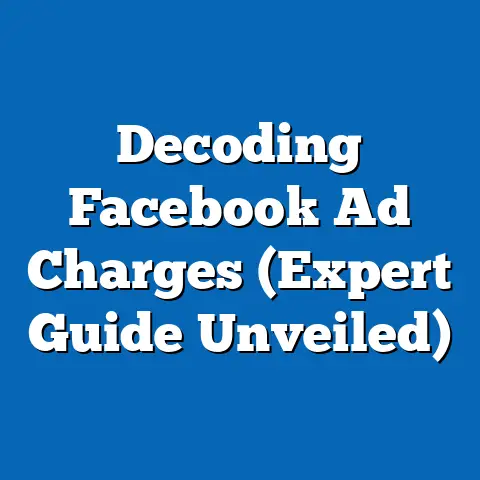Choosing the Right Facebook Ad Objective (Expert Guide)
I’ve spent countless hours navigating the ins and outs of Facebook Ads Manager, and one thing has become crystal clear: choosing the right ad objective is the cornerstone of any successful campaign. It’s not just about throwing money at the platform and hoping for the best. It’s about aligning your advertising efforts with your specific business goals and understanding where your target audience is in their journey.
Section 1: Understanding Facebook Ad Objectives
So, what exactly are Facebook ad objectives? Simply put, they are the goals you set for your advertising campaigns. They tell Facebook what you want to achieve with your ads, allowing the platform to optimize delivery and target the right audience for the desired outcome.
Think of it like telling a GPS where you want to go. If you don’t enter the correct destination, you’re going to end up somewhere you didn’t intend to be. Similarly, if you choose the wrong ad objective, you’ll likely waste your budget and fail to achieve your business goals.
Facebook organizes its ad objectives into three main categories:
- Awareness: These objectives focus on generating interest in your product or service.
- Consideration: These objectives aim to get people thinking about your business and seeking more information.
- Conversion: These objectives encourage people to take specific actions, such as making a purchase or filling out a form.
Each category targets different stages of the customer journey. Let’s break it down:
- Awareness: This is for people who may not even know your business exists. You’re introducing yourself and making a first impression.
- Consideration: This is for people who are aware of your business but need more information to make a decision. You’re nurturing their interest and providing value.
- Conversion: This is for people who are ready to take action. You’re guiding them towards a purchase or other desired outcome.
My Personal Take: I remember one campaign where I completely overlooked the importance of aligning the objective with the customer journey. I was running a conversion campaign to a cold audience who had never heard of my client’s brand. The results were disastrous. High ad spend, zero conversions. It was a harsh lesson, but it taught me the critical importance of understanding the customer journey and choosing the right objective for each stage.
Key Takeaway: Facebook ad objectives are the foundation of your campaigns. Understanding the three main categories and how they align with the customer journey is crucial for success.
Section 2: The Awareness Objectives
The first step in any successful marketing strategy is making people aware of your brand. The awareness objectives on Facebook are designed to do just that. They’re all about getting your name out there and creating a positive first impression.
Facebook offers two primary awareness objectives:
- Brand Awareness
- Reach
Let’s dive into each one:
Brand Awareness
This objective is all about increasing recognition and familiarity with your brand. It’s about getting your brand in front of as many people as possible who are likely to be interested in what you offer. Facebook uses its data to identify users who are most likely to recall your ads, increasing the chances of them remembering your brand later.
When to Use Brand Awareness:
- Launching a new product or service: If you’re introducing something new to the market, you need to get the word out.
- Entering a new market: Expanding your business to a new geographic location? Brand awareness can help you establish a presence.
- Building long-term brand equity: Even if you’re not launching anything new, consistently running brand awareness campaigns can help build a stronger brand over time.
My Experience: I once worked with a local bakery that wanted to increase its visibility in the community. We ran a brand awareness campaign targeting people within a 5-mile radius of the bakery. The ads featured mouthwatering photos of their pastries and highlighted their unique selling points. Within a few weeks, we saw a significant increase in foot traffic and positive mentions on social media.
Reach
The Reach objective focuses on showing your ad to the maximum number of people within your target audience. Unlike brand awareness, which aims for recall, reach is simply about getting your ad seen by as many unique individuals as possible.
How Reach Differs from Brand Awareness:
- Brand Awareness: Optimizes for people who are likely to remember your ad.
- Reach: Optimizes for showing your ad to the most people possible, regardless of recall.
When to Use Reach:
- Promoting a limited-time offer: If you have a sale or promotion that’s only running for a short period, reach can help you get the message out quickly.
- Announcing a local event: If you’re hosting an event in a specific location, reach can help you target people in that area.
- Running a retargeting campaign: Reach can be effective for retargeting users who have already interacted with your brand.
Real-World Example: A local music festival wanted to promote its upcoming event. They used the Reach objective to target music lovers in the surrounding area. The ads featured the festival lineup and ticket information. They were able to reach a large audience and generate significant buzz around the event.
Statistics to Consider:
- According to Facebook, brand awareness campaigns can increase ad recall by up to 66%.
- Reach campaigns can be a cost-effective way to get your message in front of a large audience.
Key Takeaway: Awareness objectives are essential for building brand recognition and getting your message out to a broad audience. Choose Brand Awareness if you want to increase recall, and choose Reach if you want to maximize the number of people who see your ad.
Section 3: The Consideration Objectives
Once you’ve made people aware of your brand, the next step is to get them thinking about your business and seeking more information. This is where the consideration objectives come into play. They’re designed to nurture interest and encourage engagement.
Facebook offers a variety of consideration objectives, including:
- Traffic
- Engagement
- App Installs
- Video Views
- Lead Generation
- Messages
Let’s explore each one in detail:
Traffic
How to Optimize Landing Pages:
- Clear and concise messaging: Make sure your landing page clearly communicates the value of your offer.
- Compelling visuals: Use high-quality images and videos to capture attention.
- Strong call-to-action: Tell users exactly what you want them to do (e.g., “Shop Now,” “Learn More,” “Sign Up”).
- Mobile-friendly design: Ensure your landing page is optimized for mobile devices.
- Fast loading speed: Nobody likes waiting for a slow-loading page. Optimize your page for speed.
My Experience: I once ran a traffic campaign for an e-commerce client that was promoting a new line of clothing. We A/B tested different landing pages and found that the page with a video showcasing the clothing performed significantly better than the page with just images.
Engagement
The Engagement objective focuses on increasing social interaction with your posts. This can include likes, comments, shares, event responses, and page likes. It’s about building a community around your brand and fostering a sense of connection with your audience.
Different Types of Engagement Ads:
- Post Engagement: Encourages users to like, comment, and share your posts.
- Page Likes: Promotes your Facebook page and encourages users to like it.
- Event Responses: Promotes an event and encourages users to RSVP.
Best Practices for Engagement Ads:
- Create compelling content: Your content should be interesting, informative, or entertaining.
- Ask questions: Encourage users to engage by asking questions in your posts.
- Run contests and giveaways: These can be a great way to generate excitement and engagement.
- Respond to comments and messages: Show your audience that you care about their feedback.
Real-World Example: A local restaurant ran an engagement campaign to promote its new menu. They posted photos of their dishes and asked users to comment with their favorite food. They received hundreds of comments and generated significant buzz around the new menu.
App Installs
If your business has a mobile application, the App Installs objective is essential. It’s designed to drive users to download and install your app.
Tips for Optimizing Ad Creatives:
- Showcase your app’s features: Highlight the key benefits and features of your app.
- Use compelling visuals: Use high-quality screenshots and videos to showcase your app’s interface.
- Target the right audience: Target users who are likely to be interested in your app.
- A/B test different ad creatives: Experiment with different visuals and messaging to see what performs best.
Key Takeaway: App Installs are crucial for businesses that rely on mobile applications. Optimizing ad creatives and targeting the right audience are key to success.
Video Views
Video content is becoming increasingly important in advertising. The Video Views objective is designed to get your videos seen by as many people as possible. It’s about increasing brand awareness, driving engagement, and ultimately, generating leads and sales.
Insights on Creating Engaging Video Ads:
- Keep it short and sweet: Attention spans are short. Aim for videos that are 15-30 seconds long.
- Capture attention in the first few seconds: The first few seconds are crucial for grabbing viewers’ attention.
- Tell a story: Engage viewers by telling a compelling story.
- Use visuals: Use high-quality visuals to keep viewers interested.
- Include a call-to-action: Tell viewers what you want them to do after watching the video.
Metrics to Track:
- Video views: The number of times your video has been viewed.
- Watch time: The average amount of time viewers spend watching your video.
- Completion rate: The percentage of viewers who watch your video to the end.
- Engagement rate: The number of likes, comments, and shares your video receives.
My Personal Take: I’ve found that video ads are incredibly effective when done right. However, it’s important to remember that quality matters. A poorly produced video can actually damage your brand. Invest in high-quality video production to ensure your ads make a positive impression.
Lead Generation
The Lead Generation objective helps businesses gather leads directly from Facebook. This objective allows you to create lead forms that users can fill out without ever leaving the platform.
Advantages of Using Lead Forms vs. External Landing Pages:
- Convenience: Users can fill out the form without leaving Facebook, making the process more convenient.
- Pre-filled information: Facebook can pre-fill some of the form fields with users’ information, making the process even faster.
- Mobile-friendly: Lead forms are optimized for mobile devices.
Best Practices for Lead Generation Ads:
- Offer a valuable incentive: Give users a reason to fill out your form (e.g., a free ebook, a discount code, a consultation).
- Keep the form short and simple: Don’t ask for too much information.
- Clearly communicate your privacy policy: Let users know how you’ll use their information.
- Follow up quickly: Respond to leads as soon as possible.
Real-World Example: A real estate agent ran a lead generation campaign to find potential home buyers. They offered a free guide to buying a home and collected leads directly from Facebook. They were able to generate a significant number of qualified leads and ultimately close several deals.
Messages
The Messages objective allows businesses to connect directly with potential customers through Facebook Messenger. This can be a great way to provide personalized support, answer questions, and ultimately, drive sales.
Tips on Crafting Compelling Conversational Ads:
- Start with a friendly greeting: Make users feel welcome.
- Ask questions: Encourage users to engage by asking questions.
- Provide helpful information: Answer users’ questions and provide them with valuable information.
- Offer personalized support: Provide personalized support based on users’ needs.
- Include a call-to-action: Tell users what you want them to do (e.g., “Learn More,” “Get a Quote,” “Book an Appointment”).
My Experience: I’ve found that the Messages objective can be incredibly effective for businesses that offer personalized services. It allows you to build relationships with potential customers and provide them with the information they need to make a decision.
Key Takeaway: Consideration objectives are all about nurturing interest and encouraging engagement. Choose the objective that best aligns with your specific goals and target audience.
Section 4: The Conversion Objectives
The ultimate goal of most advertising campaigns is to drive conversions. Whether it’s making a sale, generating a lead, or driving foot traffic to your store, the conversion objectives are designed to help you achieve specific actions.
Facebook offers three primary conversion objectives:
- Conversions
- Catalog Sales
- Store Traffic
Let’s explore each one in detail:
Conversions
The Conversions objective is used to drive specific actions on your website, such as making a purchase, filling out a form, or signing up for a newsletter. It’s about getting people to take the desired action that ultimately contributes to your business goals.
The Importance of the Facebook Pixel and Conversion Tracking:
The Facebook pixel is a small piece of code that you install on your website. It allows you to track the actions that users take on your site after clicking on your ad. This information is crucial for optimizing your campaigns and ensuring you’re targeting the right audience.
Best Practices for Conversion Ads:
- Target a warm audience: Target users who have already interacted with your brand.
- Use compelling ad creatives: Use high-quality images and videos to capture attention.
- Offer a clear call-to-action: Tell users exactly what you want them to do.
- Optimize your landing page: Ensure your landing page is optimized for conversions.
- A/B test different ad creatives and landing pages: Experiment with different variations to see what performs best.
My Personal Take: I’ve seen firsthand how effective conversion campaigns can be when properly optimized. However, it’s important to remember that the Facebook pixel is essential for tracking results and making data-driven decisions.
Catalog Sales
The Catalog Sales objective is specifically designed for e-commerce businesses. It allows you to promote products from your product catalog directly to users on Facebook.
How Catalog Sales Ads Work:
- You upload your product catalog to Facebook.
- Facebook uses its data to identify users who are likely to be interested in your products.
- Facebook shows users ads for the products they’re most likely to purchase.
Dynamic Ads and Personalization:
Dynamic ads are a type of catalog sales ad that automatically shows users products they’ve previously viewed on your website or app. This personalization can significantly increase the chances of a conversion.
Best Practices for Catalog Sales Ads:
- Upload a high-quality product catalog: Ensure your product catalog is accurate and up-to-date.
- Use high-quality product images: Use clear and attractive product images.
- Target the right audience: Target users who are likely to be interested in your products.
- Use dynamic ads to personalize the shopping experience: Show users products they’ve previously viewed on your website or app.
Real-World Example: An online clothing retailer used catalog sales ads to promote its new fall collection. They targeted users who had previously viewed similar products on their website and showed them ads for the new collection. They saw a significant increase in sales and revenue.
Store Traffic
If you have a physical store, the Store Traffic objective can be a powerful tool for driving foot traffic to your location. It’s designed to target users who are near your store and encourage them to visit.
Strategies for Targeting Local Audiences:
- Use location targeting: Target users within a specific radius of your store.
- Use demographic targeting: Target users who are likely to be interested in your products or services.
- Use interest targeting: Target users who have expressed interest in related topics.
- Use custom audiences: Target users who have previously visited your store or website.
Best Practices for Store Traffic Ads:
- Highlight your store’s location and hours: Make it easy for users to find your store.
- Offer a special promotion: Give users a reason to visit your store.
- Use compelling visuals: Use high-quality images and videos of your store.
- Include a call-to-action: Tell users what you want them to do (e.g., “Get Directions,” “Visit Our Store,” “Shop Now”).
Key Takeaway: Conversion objectives are all about driving specific actions that contribute to your business goals. Choose the objective that best aligns with your desired outcome and target audience.
Section 5: How to Choose the Right Objective for Your Campaign
Now that you understand the different Facebook ad objectives, the next step is to choose the right one for your campaign. This can be a challenging task, but by following a systematic approach, you can increase your chances of success.
Here’s a step-by-step process for selecting the appropriate ad objective:
-
Define Your Business Goals: What do you want to achieve with your advertising campaign? Are you trying to increase brand awareness, generate leads, or drive sales? Your business goals should be the driving force behind your objective selection.
-
Understand Your Target Audience: Who are you trying to reach with your ads? What are their interests, demographics, and behaviors? Understanding your target audience is crucial for choosing the right objective and targeting options.
-
Consider the Customer Journey: Where are your target audience members in their journey? Are they aware of your brand, considering your products, or ready to make a purchase? Choose an objective that aligns with their current stage in the journey.
-
Assess Your Budget: How much money are you willing to spend on your advertising campaign? Different objectives have different costs, so it’s important to choose one that fits your budget.
-
Estimate Your Expected ROI: What is your expected return on investment for your advertising campaign? Choose an objective that is likely to generate a positive ROI.
-
A/B Test Different Objectives: Experiment with different objectives to see what performs best for your business. A/B testing can help you identify the most effective objective for your specific goals and target audience.
Define Your Business Goals: What do you want to achieve with your advertising campaign? Are you trying to increase brand awareness, generate leads, or drive sales? Your business goals should be the driving force behind your objective selection.
Understand Your Target Audience: Who are you trying to reach with your ads? What are their interests, demographics, and behaviors? Understanding your target audience is crucial for choosing the right objective and targeting options.
Consider the Customer Journey: Where are your target audience members in their journey? Are they aware of your brand, considering your products, or ready to make a purchase? Choose an objective that aligns with their current stage in the journey.
Assess Your Budget: How much money are you willing to spend on your advertising campaign? Different objectives have different costs, so it’s important to choose one that fits your budget.
Estimate Your Expected ROI: What is your expected return on investment for your advertising campaign? Choose an objective that is likely to generate a positive ROI.
A/B Test Different Objectives: Experiment with different objectives to see what performs best for your business. A/B testing can help you identify the most effective objective for your specific goals and target audience.
Example Scenario:
Let’s say you’re launching a new e-commerce store selling handmade jewelry. Here’s how you might choose the right ad objective:
- Business Goal: Drive sales of your jewelry.
- Target Audience: Women aged 25-45 who are interested in fashion and handmade goods.
- Customer Journey: Most of your target audience is likely unaware of your brand.
- Budget: You have a limited budget for your initial campaign.
- Expected ROI: You want to generate a positive ROI within the first month.
Based on this information, you might start with a Traffic objective to drive users to your website and introduce them to your products. Once you’ve built up some brand awareness, you could then switch to a Conversions objective to drive sales.
Key Takeaway: Choosing the right ad objective requires a deep understanding of your business goals, target audience, customer journey, budget, and expected ROI. A/B testing different objectives can help you identify the most effective approach.
Section 6: Common Mistakes to Avoid When Choosing Ad Objectives
Even with a solid understanding of Facebook ad objectives, it’s easy to make mistakes that can derail your campaigns. Here are some common pitfalls to avoid:
-
Choosing the Wrong Objective: This is the most common mistake. Make sure your objective aligns with your business goals and target audience.
-
Ignoring the Customer Journey: Don’t try to sell to someone who has never heard of your brand. Nurture their interest first.
-
Setting Unrealistic Expectations: Don’t expect to see overnight results. Building a successful advertising campaign takes time and effort.
-
Failing to Track Results: If you’re not tracking your results, you won’t know what’s working and what’s not.
-
Giving Up Too Soon: Don’t get discouraged if your initial campaigns don’t perform as expected. Adjust your strategy and keep experimenting.
Choosing the Wrong Objective: This is the most common mistake. Make sure your objective aligns with your business goals and target audience.
Ignoring the Customer Journey: Don’t try to sell to someone who has never heard of your brand. Nurture their interest first.
Setting Unrealistic Expectations: Don’t expect to see overnight results. Building a successful advertising campaign takes time and effort.
Failing to Track Results: If you’re not tracking your results, you won’t know what’s working and what’s not.
Giving Up Too Soon: Don’t get discouraged if your initial campaigns don’t perform as expected. Adjust your strategy and keep experimenting.
My Personal Take: I’ve made my fair share of mistakes when choosing ad objectives. One time, I ran a conversion campaign to a cold audience with a very expensive product. The results were terrible. I quickly realized that I needed to build awareness and nurture interest before trying to sell.
How to Adjust Campaigns if Initial Objectives Don’t Yield Expected Results:
- Re-evaluate your business goals and target audience: Are you targeting the right people? Are your goals realistic?
- Adjust your targeting options: Experiment with different demographics, interests, and behaviors.
- Improve your ad creatives: Use high-quality images and videos that capture attention.
- Optimize your landing page: Ensure your landing page is optimized for conversions.
- A/B test different objectives: Experiment with different objectives to see what performs best.
Key Takeaway: Avoiding common mistakes and being willing to adjust your campaigns are crucial for success. Don’t be afraid to experiment and learn from your mistakes.
Conclusion
Choosing the right Facebook ad objective is not just a technical task; it’s a strategic decision that can make or break your advertising campaigns. I’ve shared my experiences, insights, and best practices to help you navigate the complexities of Facebook advertising.
Remember, the key is to align your objective with your business goals, understand your target audience, and consider the customer journey. Don’t be afraid to experiment and learn from your mistakes.
By understanding the nuances of each objective, you’ll be empowered to create more effective and targeted campaigns that drive results. So, go out there, experiment with your ad objectives, and watch your advertising success soar!
Final Thoughts:
I truly believe that anyone can master Facebook advertising with the right knowledge and approach. Don’t be intimidated by the platform’s complexities. Start with the basics, learn from your experiences, and never stop experimenting.
Call to Action:
I’d love to hear about your experiences with Facebook ad objectives. Share your strategies and insights in the comments section below. Let’s learn from each other and build a community of successful Facebook advertisers. And if you’re looking for personalized guidance on your Facebook advertising strategies, feel free to connect with me for further discussions or consultations. Let’s make your advertising dreams a reality!


